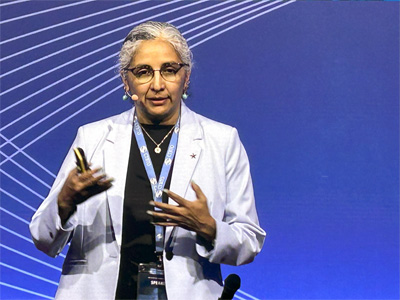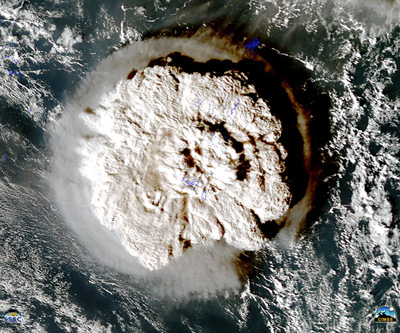8 October 2025—2025 has been a year of anniversaries for the nuclear monitoring community, some grim and some hopeful. It was 80 years ago that the first nuclear bombs devastated Hiroshima and Nagasaki. But it was nearly 30 years ago, in 1996, that the Comprehensive Test Ban Treaty opened to signature.
Before 1996, there were more than 2000 nuclear test explosions carried out around the world. After 1996, there have been less than a dozen tests detected by the massive scientific infrastructure of the International Monitoring System.
At the eighth convening of the Comprehensive Test Ban Treaty Organization (CTBTO)’s Science and Technology Conference, CTBTO Executive Secretary Robert Floyd said research was the key element in building the “trusted and trustworthy systems” that underlie the treaty’s success.
“Credible science is needed to put the treaty into force,” Floyd said in his high-level plenary to open the in-person meeting on 9 September.
The IMS, sometimes called the treaty’s backbone, is a planned global network of monitoring facilities hosted by 89 countries. The network is now 90% complete, with 307 of 321 monitoring facilities collecting real-time seismic, hydroacoustic, infrasound and radionuclide data. These facilities stream an astonishing 36 gigabytes of data per day to the CTBTO headquarters in Vienna, Austria, said Floyd.

Among the 2088 attendees of the meeting were Seismological Society of America members who presented their research on topics including numerical modeling of explosions, source characterization and discrimination, advances in seismic and infrasound technologies, teleseismic data collected from seafloor cables, and event detection from the Arabian Peninsula to the Arctic Ocean.
The approaching anniversary of the test ban treaty also had many attendees asking: How do we keep this critical global network updated and operational for the next 30 years?
Sustaining and improving the IMS
Keeping the facilities of IMS operational and up to date is a complex challenge, given that the technology at each facility ages or becomes obsolete at different rates, said Xyoli Pérez Campos, director of the CTBTO IMS Division.
In her 10 September plenary talk, Pérez Campos shared how the organization developed a long-term sustainment strategy for managing and maintaining the network’s technologies and equipment.
The strategy is “about the data,” said Pérez Campos, a former SSA Board member. “It’s about continued performance and data reliability.”
Because the IMS network has a finite number of facilities, “we can transition from focusing on installation to focusing on the sustainment of the network,” she said. “The other important thing is that because it’s now a mature network, we can transition from reactive sustainment to proactive sustainment.”
The sustainment strategy operates on a rolling 20-year period “that spreads actions over time and smooths the cost,” Pérez Campos said. “We’re talking about a network that we would like to preserve for eternity. I’m sorry, I’m a seismologist and I like to think that seismometers are going to stay forever.”
In a side event on metrology on 9 September, co-convened by SSA Past President Peggy Hellweg, speakers emphasized the challenges of maintaining reliable and stable monitoring facilities as stations age and elements are exchanged for new technologies.
Researchers must calibrate instruments such as seismometers before their deployment, for instance, but these instruments also need to be re-calibrated routinely to account for deployment conditions such as depth and temperature and potential impacts of transport to the monitoring site.
And seismometer calibration is “necessary but not sufficient” for assessing the overall health of a seismic station, said Horst Rademacher, a retired seismologist from the Berkeley Seismology Laboratory. Precision measurements of ground motion at the facilities require ensuring a stable “State of Health” that evaluates related equipment such as digitizers, processes such as data telemetry and environmental and geological conditions at the facility site, he suggested.

The event speakers also noted that as more different types of instruments are deployed for nuclear monitoring, there are multiplying issues of repair and calibration, such as the effects of seawater corrosion on hydrophones.
Along with maintaining equipment and implementing new technologies such as artificial intelligence, it is essential to maintain and train the people behind the networks, speakers agreed at a panel following Pérez Campos’ plenary.
“The other thing that keeps me awake at night is key personnel and key people, very important for the operations of the network,” said Sergio Barrientos, the director of Chile’s National Seismological Center. “And not only the operations of the network, but the know-how, the things that they know … after working for so long with the organization. They become very essential to the organization.”
Detect and distinguish
The main purpose of the IMS is to detect nuclear tests anywhere in the world, “no matter if it’s underground, underwater, or on the surface or above the surface,” said Pérez Campos. “So far, the network has fulfilled its mandate.”
The IMS has been able to locate each of the six nuclear tests conducted by North Korea since 2006. “And we see that depending on the number of stations and the occurrence of each test, the uncertainty of the location has improved. We went from an uncertain area of 800 square kilometers to about 100 square kilometers,” she noted.
Regional arrays that contain both seismic and infrasound detection have been especially useful in clarifying the depth and yield of these tests, said Junghyun Park, associate director of research at Southern Methodist University’s Seismo-Acoustic Research Program, in her 11 September presentation.
Park, who serves as deputy editor-in-chief of the Bulletin of the Seismological Society of America, discussed how she and her colleagues/collaborators are building an infrasound catalog (1999-2022) in and around the Korean Peninsula that encompasses data from North Korean nuclear tests, as well as mining activity and chemical explosions. Their studies use data from regional infrasound arrays in South Korea, in collaboration with the Korea Institutes of Geoscience and Mineral Resources and IMS infrasound stations in Japan and Russia.
Park and her collaborators at KIGAM found an unusual use for the South Korean infrasound array. “North Korea has a hydroelectric dam that sometimes opens without any notice to South Korea, and that can pose a lot of damage,” Park explained. The researchers uncovered a five-hour delay between the arrival of infrasound and the arrival of high water, “so we can use infrasound as an early warning system” for flash floods resulting from unexpected dam discharge, she noted.
Distinguishing explosion seismic signals from those created by natural tectonic events remains an important part of IMS research. After CTBTO facilities detected two small seismic events in northern Iran in October 2024, said Pérez Campos, explosion discrimination research was key to confirming that these were natural events and not nuclear tests.
“Having all these facilities located in the way that they are, operating at their best, gives you the certainty that they are not tests, or that no tests go undetected,” she said.
Data for the “polycrisis”
The IMS network has yielded some additional benefits as the test ban treaty enters its 30th anniversary year.
While the threat of nuclear weapons remains vital, the world is also facing a “polycrisis” of climate change, extreme weather and species extinction that can be addressed with IMS data, said Floyd.
Pérez Campos said the network is already being used for tsunami early warning. “CTBT has agreements with 21 countries and their tsunami early warning centers to get the data and incorporate it in their pipelines to identify the potential source of an earthquake, to better characterize and decide on the genesis of the earthquake, if it’s tsunamigenic or not,” she said. “So this is a very good tool and very high value for those countries that face the hazard of tsunamis.”

Park and her colleagues found an unusual use for the South Korean infrasound array. “North Korea has a hydroelectric dam that sometimes opens without any notice to South Korea, and that can pose a lot of damage,” Park explained. The researchers uncovered a five-hour delay between the arrival of infrasound and the arrival of high water, “so we can use infrasound as an early warning system” for flash floods resulting from unexpected dam discharge, she noted.
IMS data have been used to study decadal shifts in ocean temperature, follow the migration of whales, and characterize and measure the global impacts of the 2022 Hunga Tonga–Hunga Haʻapai eruption, among other research questions, said Pérez Campos.
She encouraged scientists around the world to explore innovative ways to use IMS data, available to Member States and to researchers through the CTBTO’s Virtual Data Exploitation Centre.
“The sustainment of the IMS network is key to protect our investment, an investment that has lots of returns, an investment that will allow us to continue providing the world with good quality data,” Pérez Campos said.
